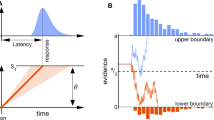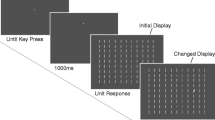Abstract
Selective attention filters irrelevant information entering our brain to allow for fine-tuning of the relevant information processing. In the visual domain, shifts of attention are most often followed by a saccadic eye movement to objects and places of high relevance. Recent studies have shown that the stimulus color can affect saccade target selection and saccade trajectories. While those saccade modulations are based on perceptual color space, the level in the visual processing hierarchy at which color selection biases saccade programming remains unclear. As color has also been shown to influence manual response inhibition which is a key function of the prefrontal cortex, we hypothesized that the effects of color on executive functions would also inherently affect saccade programming. To test this hypothesis, we measured behavioral performance and saccade metrics during a modified saccadic Stroop task which reflects competition between color words (“RED” and “GREEN”) and their color at the level of the prefrontal cortex. Our results revealed that the oculomotor system can differentially process red and green colors when planning a saccade in the presence of a competing distractor.







Similar content being viewed by others
Data availability
The datasets generated during and/or analyzed during the current study are available from the corresponding author on reasonable request.
References
Bichot NP, Rossi AF, Desimone R (2005) Parallel and serial neural mechanisms for visual search in macaque area V4. Science 308(5721):529–534. https://doi.org/10.1126/science.1109676
Blizzard S, Fierro-Rojas A, Fallah M (2017) Response inhibition is facilitated by a change to red over green in the stop signal paradigm. Front Hum Neurosci. https://doi.org/10.3389/fnhum.2016.00655
Botvinick MM, Braver TS, Barch DM, Carter CS, Cohen JD (2001) Conflict monitoring and cognitive control. Psychol Rev 108(3):624–652
Botvinick MM, Cohen JD, Carter CS (2004) Conflict monitoring and anterior cingulate cortex: an update. Trends Cogn Sci 8(12):539–546. https://doi.org/10.1016/j.tics.2004.10.003
Cohen JY, Crowder EA, Heitz RP, Subraveti CR, Thompson KG, Woodman GF, Schall JD (2010) Cooperation and competition among frontal eye field neurons during visual target selection. J Neurosci 30(9):3227–3238. https://doi.org/10.1523/JNEUROSCI.4600-09.2010
Conway BR (2018) The organization and operation of inferior temporal cortex. Annual Rev vis Sci 4:381–402. https://doi.org/10.1146/annurev-vision-091517-034202
Desimone R, Duncan J (1995) Neural mechanisms of selective visual attention. Annu Rev Neurosci 18:193–222. https://doi.org/10.1146/annurev.ne.18.030195.001205
Doyle MC, Walker R (2002) Multisensory interactions in saccade target selection: curved saccade trajectories. Exp Brain Res 142(1):116–130. https://doi.org/10.1007/s00221-001-0919-2
Doyle M, Walker R (2001) Curved saccade trajectories: voluntary and reflexive saccades curve away from irrelevant distractors. Exp Brain Res 139(3):333–344. https://doi.org/10.1007/s002210100742
Elliot AJ (2015) Color and psychological functioning: a review of theoretical and empirical work. Front Psychol 6:368. https://doi.org/10.3389/fpsyg.2015.00368
Elliot AJ, Maier MA, Moller AC, Friedman R, Meinhardt J (2007) Color and psychological functioning: the effect of red on performance attainment. J Exp Psychol Gen 136(1):154–168. https://doi.org/10.1037/0096-3445.136.1.154
Fecteau JH, Munoz DP (2006) Salience, relevance, and firing: a priority map for target selection. Trends Cogn Sci 10(8):382–390. https://doi.org/10.1016/j.tics.2006.06.011
Fortier-Gauthier U, Dell’ acqua R, Jolicœur P (2013) The “red-alert” effect in visual search: evidence from human electrophysiology. Psychophysiology 50(7):671–679. https://doi.org/10.1111/psyp.12050
Frey H-P, Honey C, König P (2008) What’s color got to do with it? The influence of color on visual attention in different categories. J vis 8(14):61–17. https://doi.org/10.1167/8.14.6
Ghasemian S, Vardanjani MM, Sheibani V, Mansouri FA (2021) Color-hierarchies in executive control of monkeys’ behavior. Am J Primatol 83(2):e23231. https://doi.org/10.1002/ajp.23231
Godijn R, Theeuwes J (2002) Programming of endogenous and exogenous saccades: evidence for a competitive integration model. J Exp Psychol Hum Percept Perform 28(5):1039–1054. https://doi.org/10.1037//0096-1523.28.5.1039
Hallett PE, Adams BD (1980) The predictability of saccadic latency in a novel voluntary oculomotor task. Vis Res 20(4):329–339. https://doi.org/10.1016/0042-6989(80)90019-X
Hermens F, Walker R (2012) The site of interference in the saccadic Stroop effect. Vis Res 73:10–22. https://doi.org/10.1016/j.visres.2012.09.017
Hodgson TL, Parris BA, Gregory NJ, Jarvis T (2009) The saccadic Stroop effect: evidence for involuntary programming of eye movements by linguistic cues. Vis Res 49(5):569–574. https://doi.org/10.1016/j.visres.2009.01.001
Hurvich LM, Jameson D (1957) An opponent-process theory of color vision. Psychol Rev 64:384–404. https://doi.org/10.1037/h0041403
Ishihara S (2006) The series of plates designed as a test for colour deficiency, Concise. Kanehara Trading Inc, Tokyo
Kehoe DH, Aybulut S, Fallah M (2018a) Higher order, multifeatural object encoding by the oculomotor system. J Neurophysiol 120(6):3042–3062. https://doi.org/10.1152/jn.00834.2017
Kehoe DH, Fallah M (2017) Rapid accumulation of inhibition accounts for saccades curved away from distractors. J Neurophysiol 118(2):832–844. https://doi.org/10.1152/jn.00742.2016
Kehoe DH, Rahimi M, Fallah M (2018b) Perceptual color space representations in the oculomotor system are modulated by surround suppression and biased selection. Front Syst Neurosci. https://doi.org/10.3389/fnsys.2018.00001
Koch C, Ullman S (1985) Shifts in selective visual attention: towards the underlying neural circuitry. Hum Neurobiol 4(4):219–227
Kugler G, ’t Hart BM, Kohlbecher S, Bartl K, Schumann F, Einhäuser W, Schneider E (2015) Visual search in the real world: color vision deficiency affects peripheral guidance, but leaves foveal verification largely unaffected. Front Hum Neurosci. https://doi.org/10.3389/fnhum.2015.00680
Laird AR, McMillan KM, Lancaster JL, Kochunov P, Turkeltaub PE, Pardo JV, Fox PT (2005) A comparison of label-based review and ALE meta-analysis in the Stroop task. Hum Brain Mapp 25(1):6–21. https://doi.org/10.1002/hbm.20129
Lee H-W, Legge GE, Ortiz A (2003) Is word recognition different in central and peripheral vision? Vis Res 43(26):2837–2846. https://doi.org/10.1016/s0042-6989(03)00479-6
Lindsey DT, Brown AM, Reijnen E, Rich AN, Kuzmova YI, Wolfe JM (2010) Color channels, not color appearance or color categories, guide visual search for desaturated color targets. Psychol Sci 21(9):1208–1214. https://doi.org/10.1177/0956797610379861
Martin PR, Lee BB, White AJ, Solomon SG, Rüttiger L (2001) Chromatic sensitivity of ganglion cells in the peripheral primate retina. Nature 410(6831):933–936. https://doi.org/10.1038/35073587
McSorley E, Haggard P, Walker R (2004) Distractor modulation of saccade trajectories: spatial separation and symmetry effects. Exp Brain Res 155(3):320–333. https://doi.org/10.1007/s00221-003-1729-5
Mehta R, Zhu RJ (2009) Blue or red? Exploring the effect of color on cognitive task performances. Science (new York, N.y.) 323(5918):1226–1229. https://doi.org/10.1126/science.1169144
Nee DE, Wager TD, Jonides J (2007) Interference resolution: Insights from a meta-analysis of neuroimaging tasks. Cogn Affect Behav Neurosci 7(1):1–17. https://doi.org/10.3758/CABN.7.1.1
Osorio D, Vorobyev M (1996) Colour vision as an adaptation to frugivory in primates. Proc Biol Sci 263:593–599 (JSTOR)
Pomerleau VJ, Fortier-Gauthier U, Corriveau I, Dell’Acqua R, Jolicœur P (2014) Colour-specific differences in attentional deployment for equiluminant pop-out colours: evidence from lateralised potentials. Int J Psychophysiol off J Int Org Psychophysiol 91(3):194–205. https://doi.org/10.1016/j.ijpsycho.2013.10.016
Ramezanpour H, Fallah M (2022) The role of temporal cortex in the control of attention. Curr Res Neurobiol 3:100038. https://doi.org/10.1016/j.crneur.2022.100038
Regan BC, Julliot C, Simmen B, Viénot F, Charles-Dominique P, Mollon JD (2001) Fruits, foliage and the evolution of primate colour vision. Philos Trans R Soc Lond Ser B 356(1407):229–283. https://doi.org/10.1098/rstb.2000.0773
Roberts KL, Hall DA (2008) Examining a supramodal network for conflict processing: a systematic review and novel functional magnetic resonance imaging data for related visual and auditory Stroop tasks. J Cogn Neurosci 20(6):1063–1078. https://doi.org/10.1162/jocn.2008.20074
Ross LE, Ross SM (1980) Saccade latency and warning signals: stimulus onset, offset, and change as warning events. Percept Psychophys 27(3):251–257. https://doi.org/10.3758/bf03204262
Saini H, Jordan H, Fallah M (2021) Color modulates feature integration. Front Psychol 12:2274. https://doi.org/10.3389/fpsyg.2021.680558
Schmolesky MT, Wang Y, Hanes DP, Thompson KG, Leutgeb S, Schall JD, Leventhal AG (1998) Signal timing across the macaque visual system. J Neurophysiol 79(6):3272–3278. https://doi.org/10.1152/jn.1998.79.6.3272
Schwedhelm P, Baldauf D, Treue S (2020) The lateral prefrontal cortex of primates encodes stimulus colors and their behavioral relevance during a match-to-sample task. Sci Rep 10(1):4216. https://doi.org/10.1038/s41598-020-61171-3
Sheliga BM, Craighero L, Riggio L, Rizzolatti G (1997) Effects of spatial attention on directional manual and ocular responses. Exp Brain Res 114(2):339–351. https://doi.org/10.1007/pl00005642
Sheliga BM, Riggio L, Rizzolatti G (1994) Orienting of attention and eye movements. Exp Brain Res 98(3):507–522. https://doi.org/10.1007/BF00233988
Sheliga BM, Riggio L, Rizzolatti G (1995) Spatial attention and eye movements. Exp Brain Res 105(2):261–275. https://doi.org/10.1007/BF00240962
Smit AC, Van Gisbergen JAM (1990) An analysis of curvature in fast and slow human saccades. Exp Brain Res 81(2):335–345. https://doi.org/10.1007/BF00228124
Smit AC, Van Opstal AJ, Van Gisbergen JAM (1990) Component stretching in fast and slow oblique saccades in the human. Exp Brain Res 81(2):325–334. https://doi.org/10.1007/BF00228123
Stroop JR (1935) Studies of interference in serial verbal reactions. J Exp Psychol 18(6):643–662. https://doi.org/10.1037/h0054651
Tamura H, Tanaka K (2001) Visual response properties of cells in the ventral and dorsal parts of the macaque inferotemporal cortex. Cereb Cortex 11(5):384–399. https://doi.org/10.1093/cercor/11.5.384
Tchernikov I, Fallah M (2010) A color hierarchy for automatic target selection. PLoS ONE. https://doi.org/10.1371/journal.pone.0009338
Tipper SP, Howard LA, Paul MA (2001) Reaching affects saccade trajectories. Exp Brain Res 136(2):241–249. https://doi.org/10.1007/s002210000577
Treisman A (1985) Preattentive processing in vision. Comput vis Gr Image Process 31(2):156–177. https://doi.org/10.1016/S0734-189X(85)80004-9
Tsotsos JK (2011) A computational perspective on visual attention. MIT Press
Van der Stigchel S, Meeter M, Theeuwes J (2006) Eye movement trajectories and what they tell us. Neurosci Biobehav Rev 30(5):666–679. https://doi.org/10.1016/j.neubiorev.2005.12.001
Viviani P, Berthoz A, Tracey D (1977) The curvature of oblique saccades. Vision Res 17(5):661–664. https://doi.org/10.1016/0042-6989(77)90143-2
Vogels R, Orban GA (1994) Activity of inferior temporal neurons during orientation discrimination with successively presented gratings. J Neurophysiol 71(4):1428–1451. https://doi.org/10.1152/jn.1994.71.4.1428
Walker R, Deubel H, Schneider WX, Findlay JM (1997) Effect of remote distractors on saccade programming: evidence for an extended fixation zone. J Neurophysiol 78(2):1108–1119. https://doi.org/10.1152/jn.1997.78.2.1108
Walker R, McSorley E (2008) The influence of distractors on saccad-target selection: saccade trajectory effects. J Eye Mov Res. https://doi.org/10.16910/jemr.2.3.7
Weaver MD, Lauwereyns J, Theeuwes J (2011) The effect of semantic information on saccade trajectory deviations. Vis Res 51(10):1124–1128. https://doi.org/10.1016/j.visres.2011.03.005
White BJ, Theeuwes J, Munoz DP (2012) Interaction between visual- and goal-related neuronal signals on the trajectories of saccadic eye movements. J Cogn Neurosci 24(3):707–717. https://doi.org/10.1162/jocn_a_00162
Wolfe JM (2010) Visual Search. Curr Biol CB 20(8):R346-349. https://doi.org/10.1016/j.cub.2010.02.016
Yantis S (1993) Stimulus-driven attentional capture and attentional control settings. J Exp Psychol Hum Percept Perform 19(3):676–681. https://doi.org/10.1037/0096-1523.19.3.676
Acknowledgements
H.R. was supported by a Vision: Science to Applications (VISTA) postdoctoral fellowship award. M.F. was supported by an NSERC Discovery Grant and CIHR Project Grant.
Author information
Authors and Affiliations
Corresponding authors
Ethics declarations
Conflict of interest
None.
Additional information
Communicated by Melvyn A. Goodale.
Publisher's Note
Springer Nature remains neutral with regard to jurisdictional claims in published maps and institutional affiliations.
Rights and permissions
Springer Nature or its licensor holds exclusive rights to this article under a publishing agreement with the author(s) or other rightsholder(s); author self-archiving of the accepted manuscript version of this article is solely governed by the terms of such publishing agreement and applicable law.
About this article
Cite this article
Ramezanpour, H., Blizzard, S., Kehoe, D.H. et al. Oculomotor system can differentially process red and green colors during saccade programming in the presence of a competing distractor. Exp Brain Res 240, 2847–2860 (2022). https://doi.org/10.1007/s00221-022-06459-8
Received:
Accepted:
Published:
Issue Date:
DOI: https://doi.org/10.1007/s00221-022-06459-8




